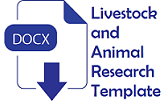Morphometrics characterization in White Fulani, Muturu and Pasundan cows
Abstract
Objective: This study was aimed to characterize three different cattle breeds based on the morphometrics.
Methods: Five (5) morphometrics which include body length (BL), chest girth (CG), withers height (WH), rump length (RL) and chest depth (CD) were measured in each animal. A total of 119 cows belonging to White Fulani (40 heads), Muturu (40 heads) and Pasundan (39 heads) were used in this study. The age of animal study was 20.93±1.62 months (White Fulani), 21.63±1.75 months (Muturu) and 20.46±2.99 months (Pasundan). Hence, two statistical methods of canonical discriminant analysis (CDA) and hierarchical cluster analysis (HCA) methods were computed in this study to characterize of animals based on their morphometrics using SPSS 16.0 package.
Results: Mostly the morphometrics of White Fulani and Pasundan cows are similar while those of Muturu are significantly lower than the two other breeds. Four morphometric measurements of CG, RL, BL and WH were identified as a discriminator variables in animal study based on the CDA method. The CDA of morphometrics able to classify 85% (White Fulani), 100% (Muturu) and 74.4% (Pasundan) of the animal into their original breed group.
Conclusions: The closeness between observations from White Fulani and Pasundan might be due to them being both Zebu (Bos indicus) unlike the Muturu with a type breed of Bos bracycheros.
Keywords
Full Text:
PDFReferences
- Pitt, D., N. Sevane, E. L. Nicolazzi, D. E. MacHugh, S. D. E. Park, L. Coll, R. Martinez, M. W. Bruford, and O. W. Pablo. 2017. Domestication of cattle: Two or three events? Evol. Appl. 12:123-136. Doi: 10.1111/eva.12674
- Utsunomiya, Y. T., M. Milanesi, M. R. S. Fortes, L. R. Porto-Neto, A. T. H. Utsunomiya, M. V. G. B. Silva, J. F. Garcia, and P Ajmone-Arsan. 2019. Genomic clues of the evolutionary history of Bos indicus cattle. Anim. Genet. 50:557-568. Doi: 10.1111/age.12836
- Hartatik T, D. N. H. Hariyono, and Y. Adinata. 2019. Genetic diversity and phylogenetic analysis of two Indonesian local cattle breeds based on cytochrome-b gene sequences. Biodiversitas. 20:17-22. Doi: 10.13057/biodiv/d200103
- Wulandari, A., V. M. A. Nurgiartiningsih, Kuswati, T. E. Susilorini, and P. P. Agung. 2019. Kinship of several Indonesian local cattle by using DNA mitochondrial COI (Cytochrome Oxidase Sub-unit I). Int. Res. J. Adv. Eng. Sci. 4:165-167.
- Laosutthipong, C. and P. Chuawongboon. 2018. Genetic relationship of maternal lineages in Phetchaburi native cattle. Int. J. Agric. Tech. 14:1379-1390.
- Abdulfatai, T., Y. T. Utsonomiya, A. G. Ezekwe, O. Nashiru, and O. Hanotte. 2019. Genome sequence analysis reveals selection signatures in endangered Trypanotolerant West African Muturu cattle. Front. Genet. 10. Doi: org/10.3389/fgene.2019.00442
- Boujenane I, L. Derqaoui, and G. Nouamane. 2016. Morphological differentiation between two Marocco goat breeds. J. Livest. Sci. Tech. 4:31-38.
- Pundir, R. K., P. K. Singh, and D. K. Sadana. 2015. Multivariate analysis of morphometric traits of three different indigenous cattle populations from North East States of India. JITV. 20:79-86. Doi: 10.14334/jitv.v20i2.1162
- Yakubu, A., K. O. Idahor, H. S. Haruna, M. Wheto, and S. Amusan. 2010. Multivariate analysis of phenotypic differentiation in Bunaji and Sokoto Gudali cattle. Acta Agric. Slov. 96:75-80. Doi: 10.2478/v10014-010-0018-9
- Merga, Y. N. and Y. Tadesse. 2020. Morphological variations of Arsi, Kereyu and their crossbred cattle under current climate change in Mid Rift Valley of Oromia, Ethiopia. Res. J. Agric. Sci.Res. 8:630-648. Doi: 10.14662/ARJASR2020.440
- Putra, W. P. B., F. Hilmawan, and J. Arifin. 2020. Characterization in two Indonesian Bos indicus cattle breeds based on morphometrical measurements. Turk. J. Vet. Res. 4:29-32.
- Ozkaya S. and Y. Bozkurt. 2008. The relationship of parameters of body measures and body weight by using digital image analysisin pre-slaughter cattle. Arch. Tierz. 51:120-128. Doi: 10.5194/aab-51-120-2008
- Alderson, G. L. H. 1999. The development of a system of linear measurements toprovide an assessment of type and function of beef cattle. AGRI. 25:45-55.
- Edouard, N. K., B. K. Lacine, K. N. Cyrille, L. K. Etienne, G. K. Dayo, S. Mamadou, and Y. G. C. Valentine. 2018. Multivariate analysis for morphological characteristics of N’Dama cattle breed in two agro-ecological zones of Cote de Ivoire. Europ. Sci. J. 14:603-621. Doi: 10.19044/esj.2018.v14n3p602
- Anya, M. I., O. B. Dauda, A. Ayuk, and M. G. Chukwumati. 2018. Phenotypic characterization of cattle based on coat colour in Obudu grass plateau, South-south Nigeria: A discriminant approach. Nigerian J. Anim. Sci. 20:1-9.
- Goitom, S., M. G. Gicheha, K. Ngeno, and F. K. Njonge. 2019. Morphological characterisation of indigenous cattle breeds in Eritrea. Adv. Anim. Vet. Sci. 7:848-857.
- Congo, R. C., C. B. Capote, A. G. Martinez, O.C. Falquez, J. M. L. Jurado, J. M. A. Reyes, and A. G. Martinez. 2019. Biometric study of Criollo Santa Elena Peninsula cattle (Ecuador). Rev. Mex. Cienc. Pecu. 10:819-836. Doi: 10.22319/rmcp.v10i4.4850
- Shaibu, S. S., D. S. Gwasa, J. O. Egahi, and H. Elkana. 2021. Application of the discriminant analysis on the forest Muturu cattle in different locations in Southern Zone of Nigeria. AJB2T. 7:12-19. Doi: 10.7934/AJB2T/2021/v7i230096
- Lombebo W. A. and N. A. Zeleke. 2018. On farm phenotypic characterization of local cattle populations in Hadiya Zone, Southern Region, Ethiopia. Adv. Dairy. Res. 6. Doi: 10.4172/2329-888x.1000218
- Popoola, M. A., and S. O. Oseni. 2018. Multifactorial discriminant analysis of cephalic morphology of indigenous breeds of sheep in Nigeria. Slovak. J. Anim. Sci. 51:45-51.
Refbacks
- There are currently no refbacks.










